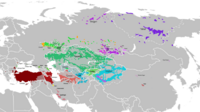
Photo from wikipedia
Prior studies investigating the association between acculturation and adolescent adjustment have often focused on specific acculturation domains rather than examining these domains collectively in a profile typology. Here, we investigate… Click to show full abstract
Prior studies investigating the association between acculturation and adolescent adjustment have often focused on specific acculturation domains rather than examining these domains collectively in a profile typology. Here, we investigate stability and change patterns in Mexican American adolescent acculturation profiles over time, using a two-wave longitudinal dataset spanning 5 years. Using latent profile analysis, three adolescent acculturation profiles were identified at Waves 1 and 2: integrated; moderately integrated; and moderately assimilated. Using latent transition analysis, four acculturation transition profiles were identified across time: stable integrated; stable moderately integrated; progressive; and regressive. Over half of all adolescents were identified as belonging to the stable integrated and stable moderately integrated transition profiles. Adolescents classified in the stable integrated profile reported the highest levels of adjustment (academic competence and socioemotional well-being) relative to those with other transition profiles. Findings from this study contribute to a comprehensive understanding of the dynamic process of acculturation among Mexican American adolescents, and provide useful insights to inform interventions and policies aimed at improving Mexican-origin adolescents' adaption to US culture while maintaining their heritage Mexican culture.
Journal Title: New directions for child and adolescent development
Year Published: 2021
Link to full text (if available)
Share on Social Media: Sign Up to like & get
recommendations!